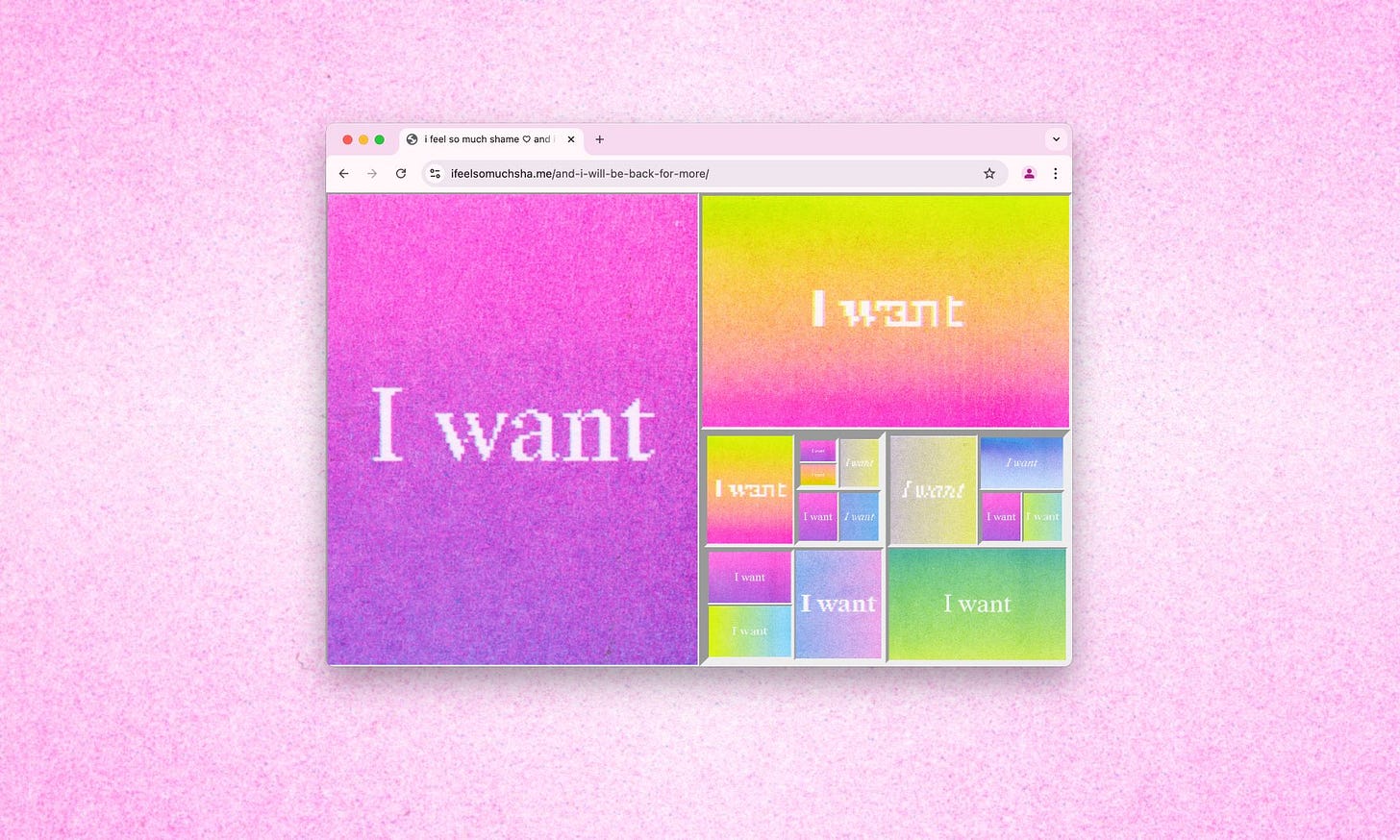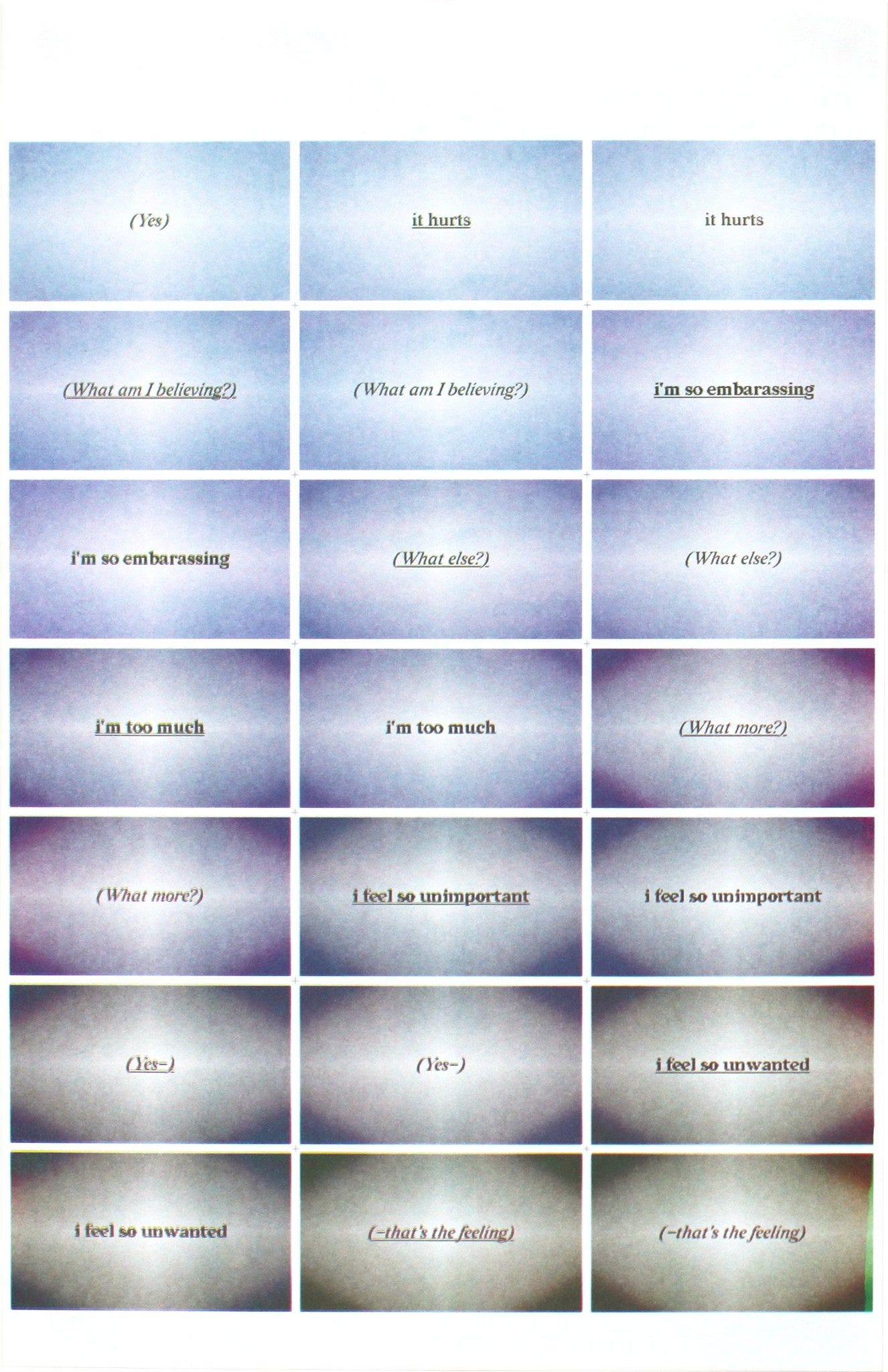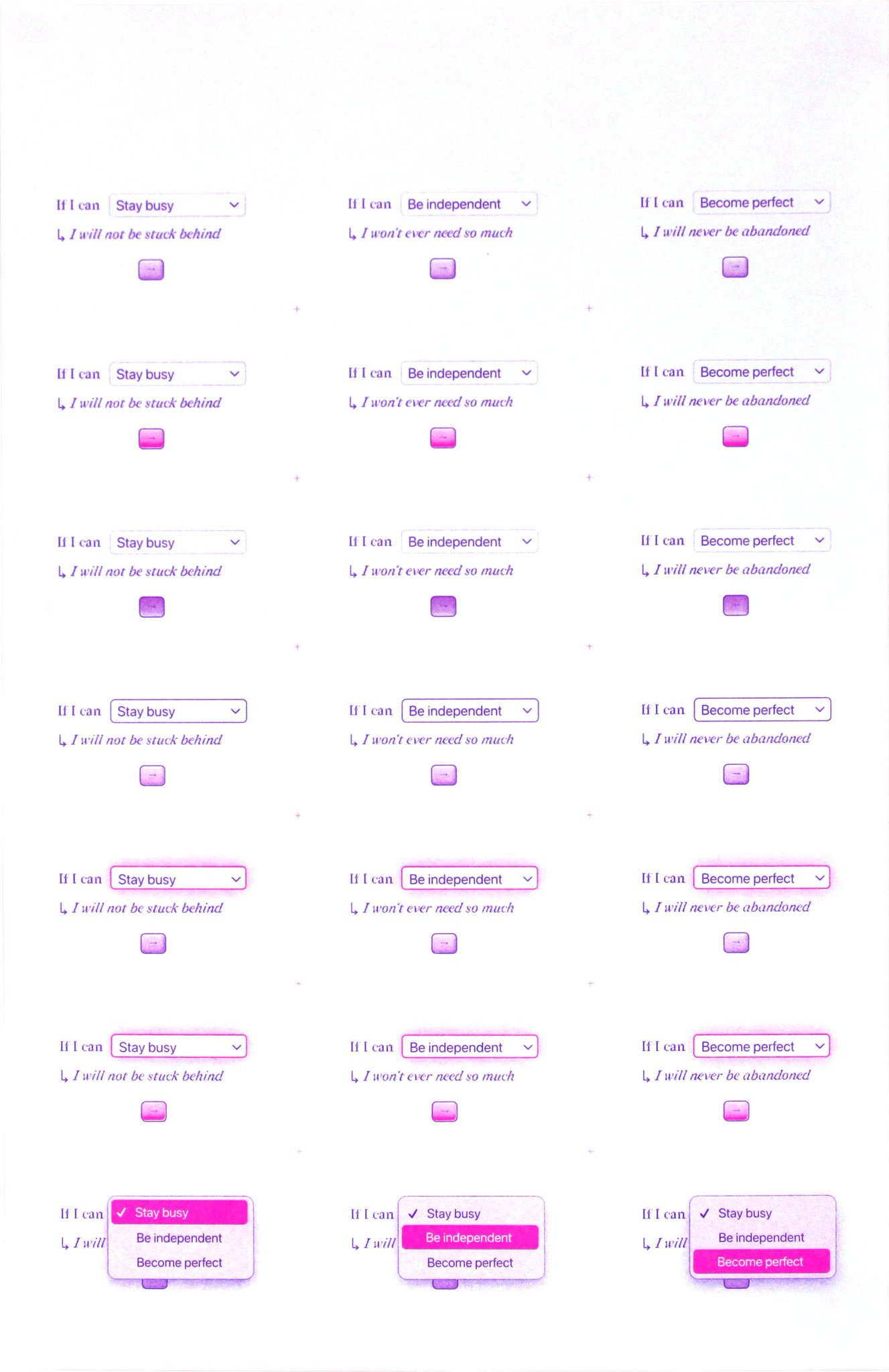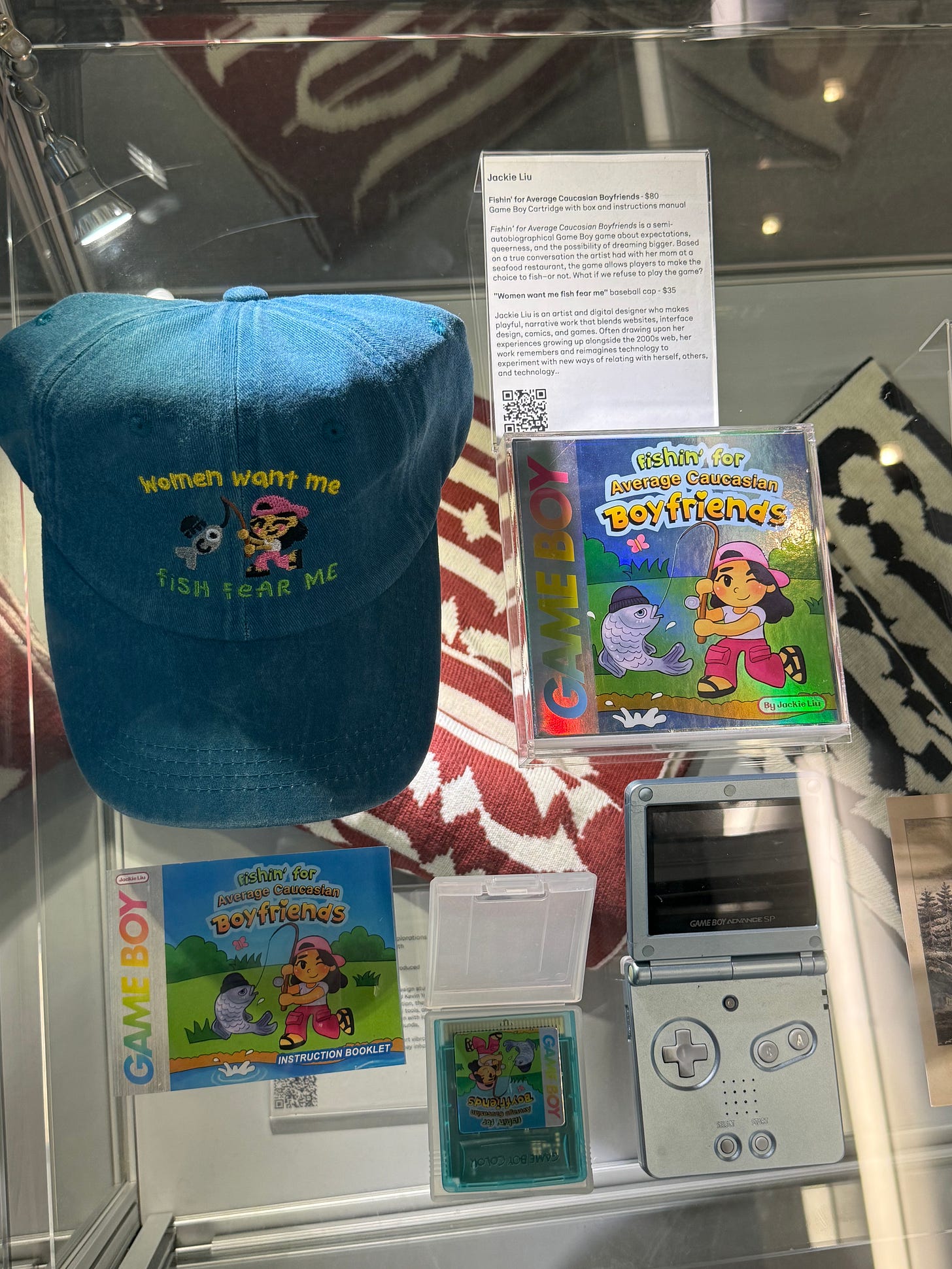This interactive browser narrative will make you feel
To make "i feel so much shame," Jackie Liu combined Risograph printing and web-based elements including dropdown menus, hyperlinks, and buttons.
Today’s issue of PHONE TIME includes a conversation with artist and designer Jackie Liu about her browser-based interactive project “i feel so much shame,” and other narrative work. Updated June 16

Jackie Liu is an artist and digital designer whose work explores internet nostalgia, narrative experiences, and the relationship between technology and play.
One of Liu’s recent projects is “i feel so much shame,” which you can check out at ifeelsomuchsha.me (view on desktop using Chrome or Arc for the best experience). “Inspired by Risograph animation techniques, it offers a meditation on shame and desire as told through interactive and animated buttons, hyperlinks, inputs, and background gradients made embodied and material, with each and every moment of the website existing in printed form,” Liu wrote on her website.
I spoke with Liu about “i feel so much shame,” her inspirations, and her other projects. This interview has been edited for length and clarity.
PHONE TIME: On your website, you mention how your work draws from your experiences growing up on the 2000s internet. Tell me a bit about that.
JACKIE LIU: I think my experience of the internet in the 2000s is that I was really into “Avatar: The Last Airbender,” then later “Naruto.” I got into very specific fan communities around 2006 and 2007 and started doing digital art. There’s a type of online forum called Oekaki—it’s a Japanese online drawing board with different boards for topics and fan communities.
My corner of the internet was very much that, like DeviantArt, playing Flash games. I think that’s impacted the way that I engage in art right now. There is this bent toward illustration, comics-y narrative storytelling, which I think comes from my childhood brain being fed and participating in that sort of subculture.
PHONE TIME: “i feel so much shame” is one of your more recent projects. How did that come together? What were your inspirations?
LIU: I think the idea came from two places. One is that I had been observing people doing Riso animation for a while. I just thought that was so beautiful and such an interesting digital plus handmade effect. Part of it was a research or technical question of applying that to an interactive format.
The second part is working through experiences of my personal shame—feelings of embarrassment about having a crush or having desires, and trying to do work that dissects that and allows me to come out the other end feeling more confident and empowered, and less shameful. Often in my autobiographical work, I try to hit at these big feelings and questions that I’m dealing with at whatever point in my life, and try to distill that into the themes of the piece.

I think there’s a lot I see online about the ways people are making with code. “Vibe coding” is a huge thing right now, and I think there’s an appeal of getting to the end result faster and not having to do the work that’s seen as boring. And that’s being framed as kind of empowering and freeing and democratic.
But something I’m thinking about with this project is that I kind of like to deliberately do the hard and arduous things. For this project, I had to really think through every frame, print it out, go through every step myself—bring my body to the Risograph studio to print and scan it and fix all the mistakes. In some ways, I’m trying to celebrate the opposite of vibe coding. Bringing yourself to do the hard work and finding some pleasure in doing that.
With this piece, the theme of shame, it’s not an easy process. You have to go through the difficult feelings to get to the other side.
PHONE TIME: You made “i feel so much shame” while participating in the “Welcome to My Homepage” digital artist residency, which was fascinating to learn about for me because I hadn’t previously known about it. Can you tell me a bit about your experience doing that?
LIU: I think the residency was really great. It’s structured as a remote residency where you’re resident for a month and get a few weeks to develop your project. They’re not too specific about what you have to create, but the end result is a website that gets parked on there. It’s a really supportive kind of residency to be part of, and also allows you to make what you want out of it.
PHONE TIME: I’m super curious about the actual process of doing the Risograph prints. Can you tell me a little about that?
LIU: The general process is first deciding what you want to print—so I figured out the narrative, the writing, all the beats and notes and scenes that I wanted. Then I blocked out all the states I would need to represent within a scene. In the dropdown scene, I studied exactly how that sort of interaction would work on the web. And dissected like, “Oh, if I hover over this part, what happens?”

For that example, I blocked out all the different states I would need to print out on Figma. Then I used Spectrolite, which is a program for laying out and splitting up Risograph prints. It puts it in a grid called a contact sheet, and you can print it out as one poster, then scan that and take each little box and stitch it together digitally back into the main experience.
“Through a laborious process of printing, scanning, and realigning over 700 images and making them interactive with HTML, CSS, and JavaScript, the making of the piece–in all of its effort, repetition, and imperfections–also becomes one of its core realizations,” Liu wrote about “i feel so much shame.”
PHONE TIME: The visual element and the color of “i feel so much shame” is also something I’m really drawn to. Was there a certain feeling or vibe you were going for?
LIU: I don’t know if you’ve seen the book “Be Not Afraid of Love” by Mimi Zhu or their writing on Instagram. It’s all very gradient, ethereal, aura vibe-based sort of visual aesthetic. I definitely drew from that, and I had the idea for the radial gradient scene very early on. I wanted it to be this kind of blossoming, powerful feeling.
A lot of it was also thinking about the nature of working in a very constrained type of project. I thought that the web 1.0 aesthetics—plain links, really basic forms would fit into that constraint of keeping it simple. I just liked the idea of something raw and stripped down to the basics—working with subject matter that’s very personal and core, but also universal.
PHONE TIME: I know the narrative and interactive element is important to a lot of your work. Why is that element so important to you?

LIU: I asked myself this a lot too. I think the part of me that’s drawn to doing game-like, interactive web work is that it’s so part of my visceral childhood experience. It’s kind of the mechanics that I absorbed as a kid.
I think interactivity can transport you into memories in a more embodied way than maybe just flipping through a traditional comic book, or reading traditional writing. There’s something visceral about digital interfaces that transport you back into time. They’re always so dated, like you can always tell what is 2012 internet versus 2016 versus 2006.
PHONE TIME: You’ve done so many different projects across different mediums. Are there ones that particularly stand out to you?
LIU: The main ones in the past few years have been “Fishin’ for Average Caucasian Boyfriends” and the Chao Bing CD-ROM.
My friend who does a lot of pixel art and games ran a queer games exhibit and invited me to make a Game Boy game, and I was just trying to think about a short visual novel type of experience I could make in a Game Boy game. I was also thinking about not liking the process of online dating and also feeling excited about a new potential romantic connection.
The main mechanic is this very boring fishing game where you just press the A button to fish for random average Caucasian boyfriends in fish form. They just say weird dating app stuff to you. Then when you don’t fish, that brings you through a five-scene introspective narrative portion where you’re able to get to the ending.
Whenever I’m doing something in a new medium, I kind of play with the medium as part of the concept itself. So I wanted to make a Game Boy game that’s like, “Oh, do you play the game or do you not?”
The other one is called “Chao Bing: A Read-Only Memory Experience.” This was the first game-like experience that I ever made, and I was trying to replicate the CD-ROM era. The ending of the game is another fourth wall breaking thing—you end up being the person who’s making the game, but also making Chao Bing, which is stir-fried scallion pancake.
PHONE TIME: As you’ve done so many different projects, have you found that your approach or what you focus on has changed over time at all? Are there things you’ve learned?
LIU: I find that there’s some stuff that has stayed the same since I started doing larger projects in college. In college, I was making sad art about breakups, so I find myself coming back to that. I think there have been moments in my life where I’m like, “I need to make work that’s more critical or academic in a specific way.” But I think lately I’m embracing making very personally-driven art.
I’m also trying to make work that’s even more stylistically nuanced. I think autobiographical work can sometimes feel a bit one-note—either all that’s sweet, or all that’s sad. In more recent work, I want things that feel intense, sad, but also funny and light-hearted at the same time.


You can find “i feel so much shame” at ifeelsomuchsha.me and Jackie Liu’s other work at jackieis.online.




